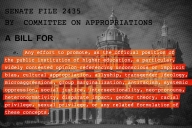You have /5 articles left.
Sign up for a free account or log in.
CHAPEL HILL, N.C. -- Administrators often brush off critics who say intercollegiate athletics detract from a university’s educational mission by countering with the claim that successful sports teams bring more attention to the institution, and in turn more donations.
While some research has identified a positive relationship between athletic success and fund-raising (and some has found no link at all), less explored is where those donors are sending their money -- and if the findings of one new study hold up, university presidents might have a tougher time making that argument in the future.
The research, presented here last week at the annual conference of the College Sport Research Institute at the University of North Carolina at Chapel Hill, again linked athletic success to increased donations -- donations to athletic programs, that is.
And the researchers found that those increased athletic donations come at the expense of academic ones -- calling into question the assertion that athletic success is inherently financially beneficial to an institution’s academic endeavors.
Gi-Yong Koo, a University of Arkansas doctoral student in sport management, and Stephen W. Dittmore, an assistant professor of recreation and sport management there, examined data from 2000-2009 at 29 institutions in the National Collegiate Athletic Association’s Football Bowl Subdivision. Koo hopes to have completed his analysis of all 120 FBS institutions within the next couple of months.
Koo and Dittmore looked at how the winning percentage of each college’s football and men’s basketball teams related to annual academic contributions, and, separately, to annual athletic contributions. They also examined the relationship between both types of contributions. The study used a random effects model to account for institutional differences.
David Clough, president of the Faculty Athletics Representatives Association and a FAR at the University of Colorado at Boulder, said he was “encouraged” to see researchers delving into this issue.
“The question of whether intercollegiate athletics affects private giving to institutions has been around as long as I can remember, as a faculty member,” Clough said in an e-mail. “One naïve stance that some faculty are known to take is that giving can be readily converted; in other words, private donations to athletics can be redirected to academic ends. As development officers well know, donors have their comfort zone, whether it be a particular academic department, a specific academic program, or an athletics team, and redirection is not readily accomplished.”
All athletics-related variables that Koo and Dittmore looked at (football and basketball winning percentages, and athletic giving) were negatively associated with academic giving, while the opposite was true for non-athletic variables such as school ranking and personal income.
A rise in athletic giving equals a decrease in academic operating dollars (academic giving minus deferred gifts), the researchers say, indicating that athletic giving crowds out academic giving.
For every $1 increase in athletic giving, the current operating dollars restricted to academic purposes decreased by $1.40.
Amy Perko, executive director of the Knight Commission on Intercollegiate Athletics, contrasted the findings with a 2009 survey of FBS presidents that her organization conducted.
“[That survey] found that a majority of presidents ‘do not view fund-raising for athletics and academics as a zero-sum game, in which financial gains for athletics programs are made at the expense of the academic side of the house,' ” Perko said in an e-mail. “This study suggests that view should be re-examined empirically.”
The impact of successful programs also depends on the sport. While higher football winning percentages were associated with less academic giving, the researchers found no evidence that basketball winning percentage directly affected academic giving in any direction. But both percentages were “powerful determinants” in driving athletic giving higher.
For every 1-percentage-point increase in football winning percentage, the current operating dollars restricted to athletic purposes increased by approximately $6.7 million, while a 1-percent rise in basketball translated to an $8 million increase.
Yet for every percentage-point increase in winning for football, academic operating dollars decreased by about $16.4 million.
Clough also pointed out that an institution’s own priorities could have an impact on the findings as well.
“One important question that is, I believe, left out of the investigators' work is the emphasis placed by institutions, or their partner foundations, on fund-raising in different areas,” he said. “In other words, what percentage of foundations' operating budgets and personnel is dedicated to fund-raising for athletics versus academics? It is logical that efforts produce results, so one would expect larger athletics fund-raising staffs for programs with more athletics giving.”
But Dittmore said it’s more complicated than that.
“Literature shows a primary motive to donate to athletics is for tangible benefits such as tickets to athletic contests,” he said. “Universities that have highly demanded sports programs may have an easier time raising funds.” Further, he added that factors such as capital campaigns for on-campus facilities may have an impact.
Koo hopes that as institutions gain a better understanding of who donates where, why and when, their athletic and academic fund-raising divisions will be able to work better together.
"I believe that the success of intercollegiate athletics has been used as a successful communication tool that increases good publicity and enhances the university profile, which could in turn result in favorable private giving," he said. "However, there has been the lack of efforts to formulate strategies to develop a positive symbiotic relationship between athletics and academics. Although this study is not able to completely explain the complexity of crowding out effects of athletic giving, it is a preliminary step in understanding the association between athletic and academic giving in general."








